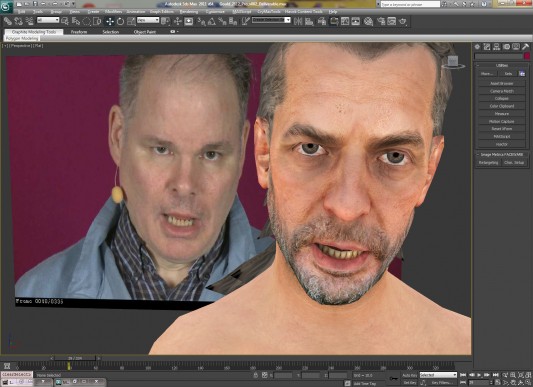I saw five key speakers, and each was fascinating in a different way:
Faceware animation software
Award-winning CGI facial animator David Bennett spoke about the capabilities of Faceware software. This program analyses video footage and produces a semi-automated model of facial expressions, allowing them to be re-created on any 3D CGI model.With a CV which includes working for Weta Digital on Avatar, Rise of the Planet of the Apes, Tintin, Beowulf and Polar Express, David certainly knows what he's talking about! I doubt he'd describe himself as a natural orator, but his video samples certainly spoke for themselves (no pun intended). This jaw-dropping software is already heavily used in both movie-making and game development.
The videos also included footage of a real-time iPad app, which superimposed a mask on a child's face. Interestingly, when responding to questions, David mentioned that the company is also involved with research into using video analysis to train people to spot when somebody is lying.
Working in the games industry
Christine Phelan is a jobbing character animator who currently works for Valve. She talked to the conference about her career path, focusing on a number of points:
- Don't be an asshole. The games industry is a small world.
- Be prepared to work hard. In the US industry, 80-90 hour weeks are not uncommon in the early stages of your career. Once you're established, you'll be able to balance life & work in a more realistic manner.
- Build an industry-focused portfolio. You need to show off the skills which will be relevant to potential employers, and concentrate on your strengths.
Aside from giving an entertaining talk, Christine also emphasised the importance of a "T-shaped" skillset -- the ability to offer specialist skills in on area, but some skills in other areas too.
'Botanicula' game
Next up were Jaromír Plachý & Peter Stehlik of Amanita Design, based in the Czech Republic. They demonstrated their point-and-click game 'Botanicula'.
This game reminded me very much of what Sheri Graner Ray said about women & casual gaming (see previous post on gender in game design). It hits a number of key design points to appeal to a female audience, including the point-and-click interface; experimental, discovery-based adventure; and constructive social interaction. It has also been described in reviews as "charming" and "delightful" -- something which ties in with an earlier post regarding the effect of charm.
While it doesn't appeal to me personally, what I have learned about game design suggests that it has great potential for success with a specific demographic. The game was released six months ago for desktop & laptop platforms and it'll be interesting to see how it sells when it reaches iPad.
Creating cinematics for games
David Brown, Phil Gray are cinematic animation directors for TT Games and were joined by production manager Bill Martin. They spoke at length about their work on cinematic cut-scenes for the Lego Batman and Lego Lord of the Rings video games.
Two points of interest stood out:
- The switch from mime to speech. Due to the need to target an international market, they had avoided characters speaking in earlier games. However, because Lego Batman had an original story, they found it difficult to impart complex story detail by mime alone. This encapsulates the eternal battle between gameplay & extrinsic narrative: with movie tie-ins like Lego Star Wars & Lego Harry Potter, players are likely to be familiar with the overarching plot, so less exposition is required. The speech and cut-scenes in Lego Batman were necessary to form an emotional interest in the characters, and to move the story along from scene-to-scene.
- Limitations of IP licensing. I asked Bill whether the Intellectual Property owners interfere much with the game development process. He answered that, thankfully, the TT developers have a good track record, so they find they're generally left to get on with their own ideas. However, Phil identified a couple of instances where licensors had blocked specific content (such as referring to "a pint" in the LoTR 'Prancing Pony' Inn scene, presumably to avoid alcohol references in certain territories). More often, ideas would be cut because they didn't fit the tone (such as doing Gandalf's famous "You shall not pass!" scene with him dressed as a school crossing guard, complete with lollipop) rather than because of licence restrictions.
From Chuckie Egg to Mass Effect
Finally, we come to Neil Thompson, who's an art director at Bioware. Neil is a superstar. There's no other way to put it. He overran his timeslot by 50% and the audience were begging for more. We only finished because the University called time.
Having worked his way from the days of the ZX Spectrum (and later the Commodore Amiga) via companies like Psygnosis/Sony and Bizarre Creations, Neil has seen a lot of success and failure in his career. Most importantly, he has learned from both.
 |
| Neil teasing the audience with concept art from Dragon Age 3. |
Conclusion
So, was the event a success? Definitely. It certainly justified the high ticket price and the two-hour knee-busting minibus trip, and I learned a great deal about the passion & creativity needed for this dynamic industry.


